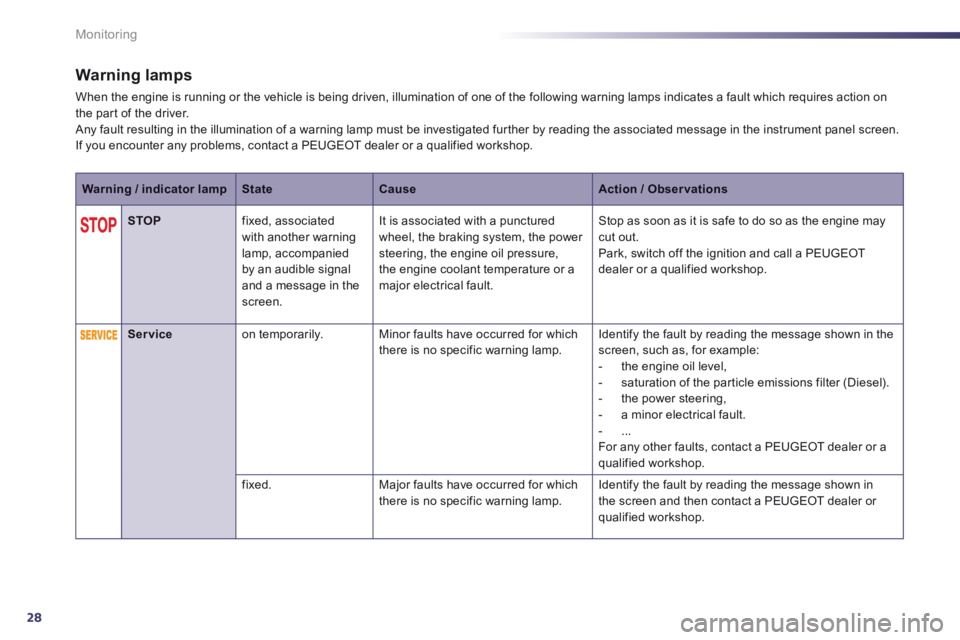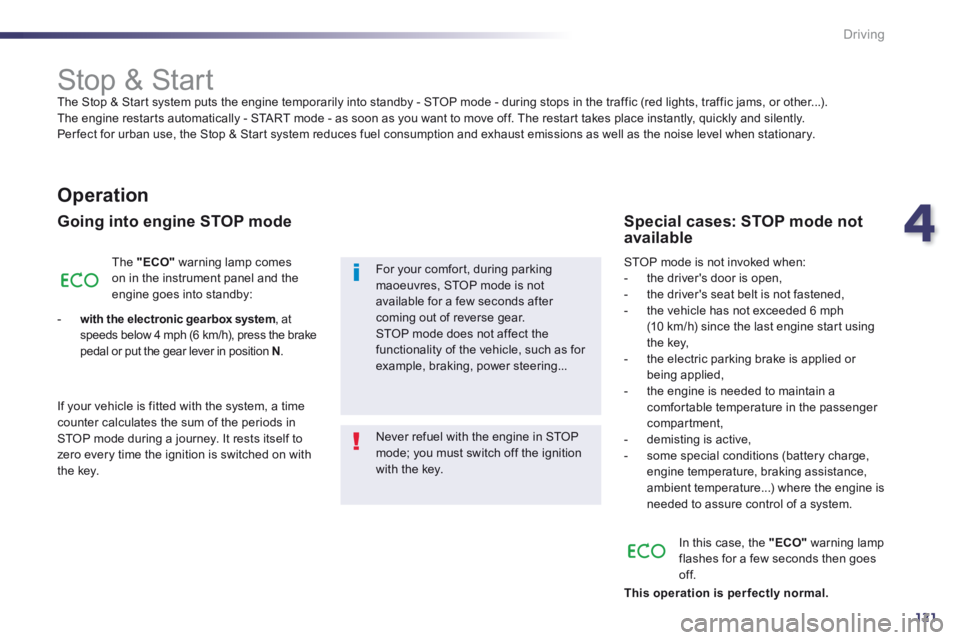Page 30 of 352

28
Monitoring
Warning lamps
When the engine is running or the vehicle is being driven, illumination of one of the following warning lamps indicates a fault which requires action on the part of the driver. Any fault resulting in the illumination of a warning lamp must be investigated further by reading the associated message in the instrument panel screen. If you encounter any problems, contact a PEUGEOT dealer or a qualified workshop.
Warning / indicator lampStateCauseAction / Observations
STOP fixed, associated with another warning lamp, accompanied by an audible signal and a message in the screen.
It is associated with a punctured wheel, the braking system, the power steering, the engine oil pressure, the engine coolant temperature or a major electrical fault.
Stop as soon as it is safe to do so as the engine may cut out. Park, switch off the ignition and call a PEUGEOT dealer or a qualified workshop.
Service on temporarily. Minor faults have occurred for which there is no specific warning lamp. Identify the fault by reading the message shown in the screen, such as, for example: - the engine oil level, - saturation of the particle emissions filter (Diesel). - the power steering, - a minor electrical fault. - ... For any other faults, contact a PEUGEOT dealer or a qualified workshop.
fixed. Major faults have occurred for which there is no specific warning lamp. Identify the fault by reading the message shown in the screen and then contact a PEUGEOT dealer or qualified workshop.
Page 123 of 352

4
121
Driving
Stop & Start The Stop & Start system puts the engine temporarily into standby - STOP mode - during stops in the traffic (red lights, traffic jams, or other...). The engine restarts automatically - START mode - as soon as you want to move off. The restart takes place instantly, quickly and silently. Per fect for urban use, the Stop & Start system reduces fuel consumption and exhaust emissions as well as the noise level when stationary.
Operation
Going into engine STOP mode
The "ECO" warning lamp comes on in the instrument panel and the engine goes into standby:
- with the electronic gearbox system , at speeds below 4 mph (6 km/h), press the brake pedal or put the gear lever in position N .
If your vehicle is fitted with the system, a time counter calculates the sum of the periods in STOP mode during a journey. It rests itself to zero every time the ignition is switched on with the key.
Never refuel with the engine in STOP mode; you must switch off the ignition with the key.
For your comfort, during parking maoeuvres, STOP mode is not available for a few seconds after coming out of reverse gear. STOP mode does not affect the functionality of the vehicle, such as for example, braking, power steering...
Special cases: STOP mode not available
STOP mode is not invoked when: - the driver's door is open, - the driver's seat belt is not fastened, - the vehicle has not exceeded 6 mph (10 km/h) since the last engine start using the key, - the electric parking brake is applied or being applied, - the engine is needed to maintain a comfortable temperature in the passenger compartment, - demisting is active, - some special conditions (battery charge, engine temperature, braking assistance, ambient temperature...) where the engine is needed to assure control of a system.
In this case, the "ECO" warning lamp flashes for a few seconds then goes of f.
This operation is perfectly normal.
Page 213 of 352

8
211
Practical information
General
recommendations
Observe the legislation in force in your c o unt r y. Ensure that the weight of the towing vehicle is higher than that of the towed vehicle. The person at the wheel of the towed vehicle must have a valid driving
licence. When towing a vehicle with all four wheels on the ground, always use an approved towing bar; rope and straps are prohibited. When towing a vehicle with the engine off, there is no longer any power assistance for braking or steering. In the following cases, you must always call on a professional recovery service: - vehicle broken down on a motor way or fast road, - 4 wheel drive vehicle, - when it is not possible to put the gearbox into neutral, unlock the steering, or release the parking brake, - towing with only two wheels on the ground, - where there is no approved towing bar available...
Towing from the rear
On the rear bumper, unclip the cover by pressing at the bottom. Screw the towing eye in fully. Install the towing bar. Switch on the hazard warning lamps on the towed vehicle.
Page 223 of 352
9
221
Checks
The various caps and covers allow access for checking the levels of the various fluids and for replacing certain components.
Petrol engines
1. Power steering reservoir. 2. Screenwash and headlamp wash reservoir. 3. Coolant reservoir.
4. Brake fluid reservoir. 5. Battery / Fuses. 6. Fusebox. 7. Air filter. 8. Engine oil dipstick. 9. Engine oil filler cap.
1.6 litre 16V VTi 120 hp
1.6 litre 16V THP 155 hp
Page 224 of 352
222
Checks
The various caps and covers allow access for checking the levels of the various fluids, for replacing certain components and for priming the fuel system.
* According to engine.
Diesel engines
1. Power steering reservoir. 2. Screenwash and headlamp wash reservoir. 3. Coolant reservoir.
4. Brake fluid reservoir. 5. Battery / Fuses. 6. Fusebox. 7. Air filter. 8. Engine oil dipstick. 9. Engine oil filler cap. 10. Priming pump * . 11. Bleed screw * . 1.6 litre HDi 115 hp
2.0 litre HDi 140 hp
Page 225 of 352
9
223
Checks
The various caps and covers allow access for checking the levels of the various fluids, for replacing certain components and for priming the fuel system.
* According to engine.
Diesel engines
1. Power steering reservoir. 2. Screenwash and headlamp wash reservoir. 3. Coolant reservoir.
4. Brake fluid reservoir. 5. Battery / Fuses. 6. Fusebox. 7. Air filter. 8. Engine oil dipstick. 9. Engine oil filler cap. 10. Priming pump * . 11. Bleed screw * . 2.0 litre HDi 160 hp
2.2 litre HDi 200 hp
Page 226 of 352
224
Checks
Blue HDi Diesel engines
The various caps and covers allow access for checking the levels of the various fluids, for replacing certain components and for priming the fuel system.
1. Power steering reservoir. 2. Screenwash and headlamp wash reservoir. 3. Coolant header tank. 4. Brake fluid reservoir. 5. Battery / Fuses. 6. Fusebox. 7. Air filter. 8. Engine oil dipstick. 9. Engine oil filler cap.
2.0 litre Blue HDi 150 hp2.0 litre Blue HDi 180 hp
Page 228 of 352

226
Checks
Power steering fluid level
The power steering fluid level should be close to the "MA X" mark. With the engine cold, unscrew the cap to check the level.
The brake fluid level should be close to the "MA X" mark. If it is not, check the brake pad wear.
Brake fluid level
Changing the fl uid
Refer to the warranty and maintenance record for details of the interval for this operation.
Fluid specifi cation
The brake fluid must conform to the manufacturer's recommendations and meet the DOT4 low viscosity / ISO 4925 Class 6 standard.
Topping up the engine oil level
Refer to the "Petrol engine" or "Diesel engine" section for the location of the oil filler cap in the engine compartment of your vehicle. Unscrew the oil filler cap to reveal the filler aperture. Add oil in small quantities, avoiding any spills on engine components (risk of fire). Wait a few minutes before checking the level again using the dipstick. Add more oil if necessary. After checking the level, carefully refit the oil filler cap and the dipstick in its tube.
After topping up the oil, the check when switching on the ignition with the oil level indicator in the instrument panel is not valid during the 30 minutes after topping up.
Engine oil change
Refer to the warranty and maintenance record for details of the interval for this operation. In order to maintain the reliability of the engine and emission control system, the use of additives in the engine oil is prohibited.